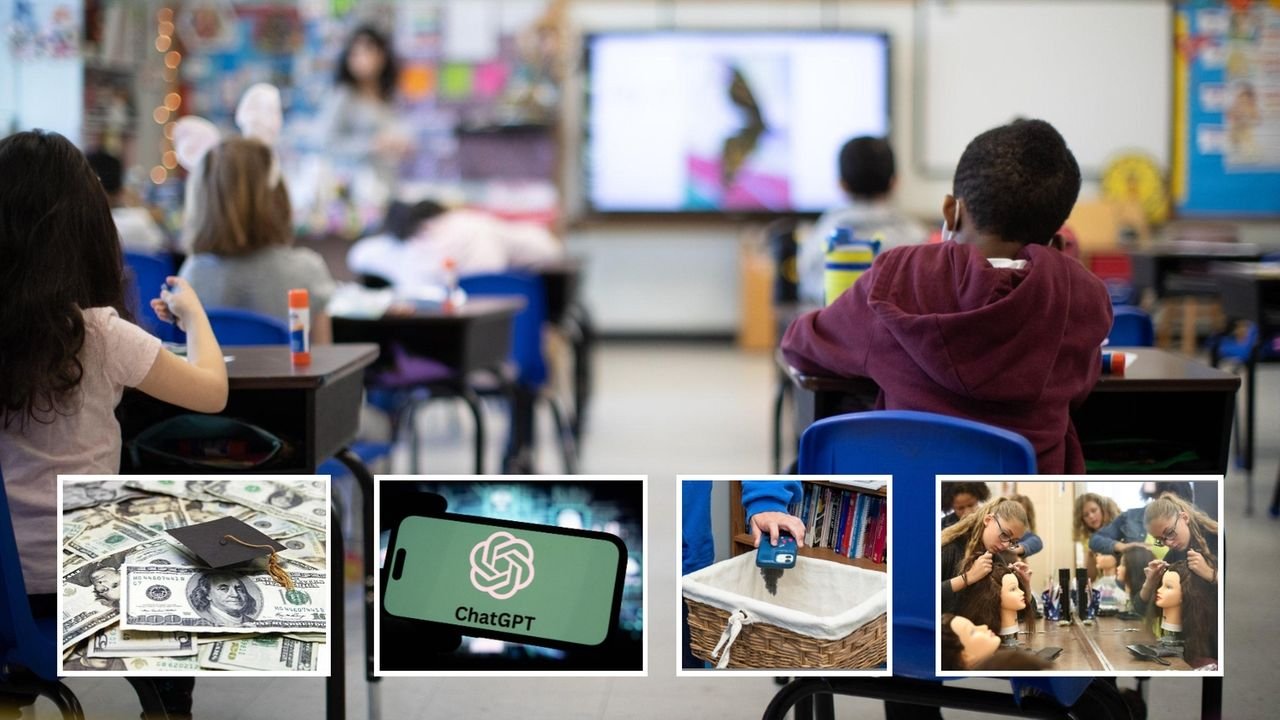Education
LI schools face critical challenges as opening day arrives

Every year brings formidable challenges for educators, but the upcoming 2025-26 school year seems to portend an especially pivotal time for Long Island students, parents and teachers. Will artificial intelligence usurp learning? How will kids and schools handle the state cellphone ban? Can schools fix the chronic absenteeism plague? Will the federal Department of Education stop funding programs vital to low-wealth districts? And are kids prepared for college or a career the day they graduate?
FUNDING CUTS AHEAD?
Teaching kids costs money — a lot. New York spends more per pupil on K-12 education than any other state, but receives only 7.3% of total education spending from Washington. Nationwide, the federal government provides an average of 13.7% of public school funding.
Since New York doesn’t receive a large percentage of its education money from the federal government, the state is better positioned — but not immune — to cuts than other states.
In 2021-22, Brentwood received 16.1% of its budget from federal funding. Cold Spring Harbor received 1.3% while Merrick received 2.3% and Garden City 2.1%. The large difference between districts means some LI schools — primarily in low-income districts and communities where minorities are predominant — will be hit especially hard by any cuts. Additionally, cuts to Department of Agriculture food programs and Department of Health and Human Services’ early childhood programs will worsen the blow.
At the same time, construction costs are rising and likely to impact the scope of new projects. Strapped taxpayers are unlikely to approve any budgets that exceed the state tax cap.
CURBING ABSENTEEISM
Learning can’t happen if kids are chronically missing lessons.
New York ranks as one of the worst states for chronic absenteeism — defined as a student missing more than 10% of school days. In a school year of 180 days, missing at least 18 days is equivalent to missing an entire month of class. The national chronic absenteeism rate was 28% in 2022-23, while New York’s was 35%.
The solution isn’t simple or cheap. Schools must offer more relevant courses, encourage the development of dynamic teachers, provide an inviting environment and serve tasty meals. Communication with parents or guardians from educators is crucial to getting kids into the building.
CAREER EDUCATION
Many Long Island districts acknowledge the reality that not every student will attend college, despite the striving by each district to have top test scores. Schools must continue to expand career and technical education while better preparing graduates who do go to college so they don’t need remedial courses. Skilled workers are in demand — on Long Island especially — and career and technical education courses can lead to a lucrative career.
Schools are also adapting to the state’s new multiple pathways to graduation initiative, which gives students the opportunity to earn a diploma specializing in a particular field of study. This will present challenges and chances for kids to get more involved in their learning. As with most issues in education, the success of the pathways to graduation model will hinge on parent involvement.
At the same time, schools must acknowledge that inflated graduation rates don’t do anyone any good in the long term. Floor grades — usually a 50 for incomplete or missing assignments — don’t prepare a student for life after school.
Also, schools must improve literacy and math skills while improving analytical thinking — perhaps the most important skill employers seek. That means teaching critical thinking, logic, philosophy and reasoning in all grades.
Don’t wait for kindergarten to start teaching kids. Every school district should offer prekindergarten spots to every child, without lotteries. This costs money and involves reorganization and planning, but the results will be worth it.
CELLPHONES, AI, SAFETY
Educators must take advantage of the new statewide ban on personal internet-enabled devices in schools to improve learning without screens. Teaching kids the personal skills to interact with their peers and adults, sadly, is now a burden for schools. But it’s an important task for educators.
Artificial intelligence in education poses a profound challenge. Educators can help kids understand that AI is a tool, not a substitute for learning and critical thinking.
Educators must keep kids safe by enhancing mental health support while keeping schools safe. Kids spend more time in school than any other place outside of home. Educators are the first responders responsible for the health and well-being of kids.
SEE YOU IN SEPTEMBER!
Eager and anxious kids are days away from the first day of school on Long Island. All but three districts open the week after Labor Day. As a region, Long Island is one of the most successful areas for public education in America. That hard-earned reputation will be tested again this year while the stress factors multiply.
Strong anti-education headwinds from myriad influences add to the already daunting task of preparing kids to be members of civil society. It’s challenging but rewarding to teach a kid to be successful, and it is truly a community effort.
Have a great start Long Island.
MEMBERS OF THE EDITORIAL BOARD are experienced journalists who offer reasoned opinions, based on facts, to encourage informed debate about the issues facing our community.
Education
US Education Department is all for using AI in classrooms: Key guidelines explained

Artificial intelligence (AI) has moved from being a futuristic concept to an active part of classrooms across the United States. From adaptive learning platforms to AI-powered lesson planning, schools are integrating technology to improve learning outcomes and ease teacher workloads. However, the challenge lies in adopting these tools without violating federal and state regulations.
Federal guidance: Innovation with safeguards
In July 2025, the US Department of Education issued guidance confirming that AI can be used in schools when aligned with federal laws. The framework focuses on three core principles—privacy, equity, and human oversight.AI tools must comply with the Family Educational Rights and Privacy Act (FERPA) to protect student data. Algorithms should be designed to prevent bias or discrimination under civil rights regulations. Human decision-making must remain central, ensuring that AI supports educators rather than replacing them.The Department also encouraged schools seeking federal grants to propose AI-driven projects, provided they meet these compliance standards.
State-level action: Rapid policy development
Since the federal guidance, more than half of US states have introduced their own AI frameworks for schools. Ohio now mandates that all districts adopt an AI-use policy by mid-2026, while Rhode Island has published detailed recommendations for responsible classroom integration.These local rules aim to ensure innovation while safeguarding student interests. However, the pace of policy development and the diversity of approaches have created a complex regulatory environment for schools.
Mixed practices at the local level
Despite progress, many districts still operate in a gray area. Policies differ widely between schools, and families often face uncertainty about what is permissible. Some institutions allow AI on personal devices while banning it on school-owned systems. In certain cases, schools have reverted to traditional measures, such as requiring handwritten essays in class to prevent AI-assisted work.This variation highlights the need for consistent guidelines and clear communication with students and parents.
AI as a classroom resource
Educators are increasingly using AI as a tool for efficiency and creativity. AI platforms assist in lesson planning, assessment design, and content generation, enabling teachers to save significant time on administrative work. These efficiencies allow more focus on interactive teaching and student engagement.AI-powered tutoring systems are also being introduced to provide personalised support, particularly for students who need extra academic help. States such as New Hampshire are experimenting with AI-driven tools to enhance math and reading instruction.
Responsible AI use: Best practices for schools
To remain compliant and maximise benefits, schools should adopt structured approaches to AI integration:
- Personalised Learning: Use adaptive platforms to tailor lessons while ensuring compliance with privacy regulations.
- Teacher Support: Allow educators to use AI for planning and administrative tasks with mandatory human review.
- Assessment Integrity: Shift from take-home essays to in-class writing or oral presentations to discourage misuse.
- Career Guidance: Deploy AI-driven counselling tools while retaining human oversight for final decisions.
Managing risks and ensuring compliance
AI adoption brings challenges that schools must address proactively:
- Bias Prevention: Regular audits are necessary to eliminate algorithmic bias.
- Privacy Protection: All tools should meet FERPA standards and undergo security checks.
- Avoiding Over-Reliance: AI should support, not replace, teacher judgment in academic and disciplinary matters.
Comprehensive district-level policies, continuous teacher training, and stakeholder engagement are essential for responsible use.
The road ahead
The Department of Education is collecting public feedback on AI-related policies and exploring ways to integrate AI into its own operations. States will continue rolling out new requirements in the coming months, making 2025 a critical year for AI in education.The future of AI in classrooms depends on a balanced approach—leveraging its potential to improve learning while upholding legal and ethical standards. Schools that integrate AI responsibly will not only enhance student outcomes but also prepare learners for a technology-driven world.
Education
State Superintendent Thurmond Convenes Statewide AI in Education Workgroup for Public Schools – Van Nuys News Press

SACRAMENTO—State Superintendent of Public Instruction Tony Thurmond hosted the first meeting today of the Public Schools: Artificial Intelligence (AI) Workgroup at the California Department of Education (CDE) Headquarters in Sacramento. Established after last year’s passage of Senate Bill 1288, a bill authored by Senator Josh Becker (13th District) and sponsored by Superintendent Thurmond, the workgroup marks California as one of the first states in the nation to establish a legislatively mandated statewide effort focused on AI in K–12 education.
“There is an urgent need for clear direction on AI use in schools to ensure technology enhances, rather than replaces, the vital role of educators,” said Superintendent Thurmond. “Workgroup members are representatives from various organizations, including technology leaders. The majority are educators, and this workgroup also includes students. We want to ensure that those who will be affected by this guidance and policy have a voice in creating it.”
The workgroup is a model of Superintendent Thurmond’s efforts to develop strong public–private partnerships that power innovation in public education. It will develop the statewide guidance and a model policy to ensure AI benefits students and educators while safeguarding privacy, data security, and academic integrity. The group includes teachers, students, administrators, classified staff, higher education leaders, and industry experts. At least half of the members are current classroom teachers, elevating educator expertise as the foundation for decision-making.
The launch of the Public Schools: Artificial Intelligence Workgroup directly advances Superintendent Thurmond’s priorities, which include
- Transforming Education with Innovation: equipping schools with equitable, forward-looking approaches to technology;
- Equity and Access for All Students: ensuring AI tools do not exacerbate inequities but instead expand opportunities for every student;
- Whole Child Support: safeguarding against bias, misuse, and misinformation in AI systems while protecting student well-being;
- Elevating Educator Voice: centering teachers in decision-making about AI in classrooms; and
- Transparency and Public Engagement: committing to openness through public meetings and shared resources.
Today was the initial meeting of the Public Schools: Artificial Intelligence Workgroup. The second meeting will take place in October, followed by a third meeting in February.
The CDE has released initial guidance for schools and educators regarding the use of AI, which will be enhanced by the work of this group. The initial guidance can be found on the CDE Learning With AI, Learning About AI web page.
Education
The Guardian view on GCSE resits: admitting the problem is just the first step | Editorial

For years, rigid rules and a shocking failure rate in compulsory GCSE retakes have been one of the exam system’s dirty secrets. At last this dire situation is getting some of the attention it deserves. This year, nearly a quarter of all maths and English language entries in England, Wales and Northern Ireland were for students aged 17 or older on a repeat attempt – with just one in six of those retaking maths managing to pass.
By calling this a crisis, Jill Duffy, who heads the OCR exam board, has thrown a spotlight on the problem. But admitting that there is an issue with resits, as officials are now doing, is only the first step. There are differing views about what ought to happen next.
Reforming GCSEs is outside the scope of the review being led by Prof Becky Francis. But a proposal to ditch compulsory resits is on the table. The Sixth Form Colleges Association wants a second attempt to be followed – for those who fail – by a modular alternative. This would mean students not being forced to endlessly repeat the parts of the courses they have mastered, and focusing instead on the gaps.
Nick Gibb, the former Conservative schools minister, has predictably set his face against change and demanded that all schools follow the example of the best. But while big variations in results should be drilled into, and successes learned from, this is not an adequate response. Many subject experts believe that the qualifications are poorly designed if their purpose is to serve as a universal gateway to the world of work. Rather than sticking to vital competencies (such as numeracy, statistics and reading comprehension), the current versions include calculus and geometry (in maths) and quasi-literary analysis (in English language).
It is a great shame that these issues were not grasped more effectively by Labour in opposition. Changes to the curriculum and exam system are a painstaking process. Prof Francis’s review is the best chance of breaking a destructive cycle. But the Department for Education’s recent record of engagement with the further education sector – where most resits are taken – is not good. There is no secondary English specialist on the review, and teacher shortages and challenges around provision for special educational needs and disabilities remain concerning.
Resits must also be seen in the context of a wider debate around the future of post-16 education, including the pledge by ministers to abolish courses that they see as unwelcome competition to T-levels. As with resits, critics of this policy are most worried about less academically able pupils with lower test scores. Even the government’s own figures show a gap, with tens of thousands of students on the threatened courses, including some BTecs, potentially unsuited to newer alternatives.
With a skills white paper due in the autumn, it is not too late to tackle unanswered questions. A better balance between ambition and pragmatism can surely be found. Plenty of jobs in the UK do not require calculus or textual analysis. T-levels were meant to boost less academic, more practical teenagers. This year’s resit figures are a worrying addition to existing evidence that these are the pupils for whom the system works least well. Ministers must be absolutely confident that any changes they introduce make things better, and not worse.
-
Tools & Platforms3 weeks ago
Building Trust in Military AI Starts with Opening the Black Box – War on the Rocks
-

 Business2 days ago
Business2 days agoThe Guardian view on Trump and the Fed: independence is no substitute for accountability | Editorial
-

 Ethics & Policy1 month ago
Ethics & Policy1 month agoSDAIA Supports Saudi Arabia’s Leadership in Shaping Global AI Ethics, Policy, and Research – وكالة الأنباء السعودية
-

 Events & Conferences3 months ago
Events & Conferences3 months agoJourney to 1000 models: Scaling Instagram’s recommendation system
-

 Jobs & Careers2 months ago
Jobs & Careers2 months agoMumbai-based Perplexity Alternative Has 60k+ Users Without Funding
-

 Funding & Business2 months ago
Funding & Business2 months agoKayak and Expedia race to build AI travel agents that turn social posts into itineraries
-

 Education2 months ago
Education2 months agoVEX Robotics launches AI-powered classroom robotics system
-

 Podcasts & Talks2 months ago
Podcasts & Talks2 months agoHappy 4th of July! 🎆 Made with Veo 3 in Gemini
-

 Podcasts & Talks2 months ago
Podcasts & Talks2 months agoOpenAI 🤝 @teamganassi
-

 Mergers & Acquisitions2 months ago
Mergers & Acquisitions2 months agoDonald Trump suggests US government review subsidies to Elon Musk’s companies





















